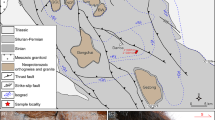Abstract
Various indirect approaches have been used to estimate the amount of the oxy end member in biotites. Since this could be used to indicate the formation temperatures and the oxygen fugacities of biotite bearing rocks, its determination requires careful experimental work. The oxidation of the iron micas annite and ferriannite has been studied by Mössbauer effect (ME) and X-ray diffraction (XRD). A model that relates ME parameters to reaction mechanism in biotites has been proposed according to which oxidation at M2 is relatively easier than oxidation at M1, a result which agrees well with the site assignment adopted. Heating synthetic ferriannite at 300° C produced an oxidation ratio that corresponds to the oxy-ferriannite end member where the ME spectra show that the two ferrous peaks are well resolved. Finally, ME and XRD results show that the c-axis decreases by 0.001 Å for every percent oxybiotite added.
Similar content being viewed by others
References
Addison CC, Addison WE, Neal GH, Sharp JH (1962) Amphiboles Part I. The oxidation of crocidolite. J. Chem Soc: 1468–1471
Annersten H (1974) Mössbauer studies of natural biotites. Am Mineral 59:143–151
Day P (1976) Mixed valence chemistry and metal chain compounds. In: Keller HJ (ed) Low dimensional cooperative phenomena, Plenum Press
Ericsson T, Wäppling R (1976) Texture effects in 3/2–1/2 Mössbauer spectra. J Phys 37:C6:719–723
Eugster H, Wones D (1962) Stability relation of the ferrigeneous biotite, annite. J Petrol 3:82–125
Hazen R, Burnham CW (1973) The crystal structure of one layered phlogopite and annite. Am Mineral 58:889–900
Hazen R, Wones D (1972) The effect of cation substitution on the physical parameters of trioctahedral micas. Am Mineral 58:889–900
Hewitt D, Wones D (1975) Physical properties of some Fe-Mg-Al trioctahedral biotites. Am Mineral 60:854–862
Hogg D, Meads RE (1975) A Mössbauer study of thermal decomposition of biotites. Mineral Mag 40:79–88
Häggström L, Wäppling R, Annersten H (1969) Mössbauer study of iron rich biotites. Chem Phys Lett 4:107–108
Loeffler BM, Burns RG, Tossell JA (1975) Metal-metal charge transfer transition: Interpretation of visible region spectra of the moon and lunar materials. Proc 6th Lunar Sci Conf 3:2663–2676
Radoslovich EW (1962) The cell dimension and symmetry of layer lattice silicates. II: Regression relation. Am Mineral 47:617–636
Sanz J, Gonzales-Carreno T, Gancedo R (1983) On dehydroxylation mechanism of a biotite in vacuo and oxygen. Phys Chem Minerals 9:14–18
Schairer JF, Bowen NL (1955) The system K2O-Al2O3-SiO2. Am J Sci 253:681–746
Vedder W, Wilkins RWT (1969) Dehydroxylation and rehydroxylation; oxidation and reduction of micas. Am Mineral 54:482–509
Wones D (1963a) Physical properties of synthetic biotites on the join phlogopite-annite. Am Mineral 48:1300–1321
Wones D (1963b) Phase equilibria of ferriannite, KFe3FeSi3O10(OH)2. Am J Sci 261:581–596
Wones D, Eugster H (1965) Stability of biotites: Experimental, theory and application. Am Mineral 50:1228–1272
Author information
Authors and Affiliations
Rights and permissions
About this article
Cite this article
Ferrow, E. Mössbauer and X-ray studies on the oxidation of annite and ferriannite. Phys Chem Minerals 14, 270–275 (1987). https://doi.org/10.1007/BF00307993
Received:
Issue Date:
DOI: https://doi.org/10.1007/BF00307993




